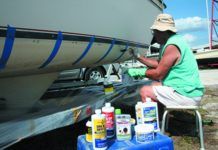Murphy Bag
A recent PS Advisor item on lightning strikes got me thinking about the possible problem of finding your way home after being hit by lightning at sea. Publications on the subject suggest that GPS and radio units are likely to be fried. What about the steering compass? One possible approach to keeping Murphy at bay comes to mind: wrap a spare GPS unit, a hand bearing compass, perhaps a hand-held VHF unit, and a pack of AA cells in cloth (for padding), put them in a small box, cover it with a couple of layers of aluminum foil, and stow the package in a dry locker aboard. Would equipment so protected have increased ability to survive a lightning bolt?
-Bob Gillette
Poland, Ohio
Were not saying it hasn’t happened, but weve never heard of a binnacle compass being destroyed by a lightning strike. Your plan for a Murphy Bag is fine, although were not sure whether the aluminum foil would help or hurt-maybe a rubber hot water bottle would be better. In any case, if things get that bad offshore-no GPS, no radio, no steering compass-you can bear in mind what Moitessier told some admirers in Newport years ago: If you want to sail from Newport to Spain, you just keep the sun in your face in the morning and at your back in the evening. When you see land, hail a passing boat and shout, “Whats that?” If the answer comes in a thick brogue, bend the course about 45 degrees to the right.
———-
Soap Solution for Dinghy Leak
I have an inflatable dinghy (Zodiac brand) that has kind of a slow leak.When I don’t use it, no water gets in, but as soon as there is some weightin the bottom, the water starts getting in very slowly, but enough so that I have an inch of water in the deepest point after 10 minutes of loading andunloading goods for a trip. I can’t see any leaks. It just seems to be a general leak! Is my dinghys life finished? Any ideas? Thank you for your good magazine.
-Jean Beaudreault
Via e-mail
Your dinghy is almost certainly not doomed, but merely has a slow leak below the waterline, which should be fairly easy to trace with the old-fashioned soapy water method: Put the dinghy upside down on a dock, have a couple of friends sit on it to create pressure, and apply a soapy water solution to the bottom by squeezing on liberally with a sponge, paying particular attention to the seams. When you see bubbling, youve found the leak.
———-
Polyethylene Repair
I have a 40- gallon polyethylene tank on a beam in the bilge for domestic water. Its cracked in a couple of places, lack of support I guess, and leaking notably. I am having a hard time repairing it.Any suggestions?
-Henry R. Koehler
Via e-mail
Try one of the plastic welders on the market. Northern Tool and Equipment (used to be Northern Hydraulics) carries one: the Model 5 Plastic Welder for $159.99. Their item number 164740. Their order number: 800-221-0516. Youll still need to figure out a way to support the tank better. Good luck.
———-
Flare Disposal
For some time weve been seeking a way to dispose of expired flares, short of the customary July 4th sendoff – where one acquaintance burned a lovely 40′ sloop to the waterline while attempting to amuse his grandchildren. No one around us seemed to know and our garden shed was filling up rapidly.
Last weekend, our yacht club offered a courtesy Coast Guard Safety Inspection, and during the examination of our boat, we asked the young officer of our local auxiliary if he knew any way we could get rid of our “stash.” He descibed the method currently used by the Coast Guard, which is simple, safe, and inexpensive.
He said they simply place a few flares at a time into a bucket of water and leave them to soak. After about 3 months (refilling the water as necessary and with an occasional stir) the flares decompose to a soft pulp. This pulp is then strained out of the liquid, which can then be poured down a drain or used on lawns or gardens, and the remaining solid matter is safely placed in the regular trash collection.
I hope this is helpful to others who may be as clueless as I was.
-Martha G. Rose
Wenham, MA
Sounds like good advice to us. Thanks, Martha.
———-
Mast Butt Corrosion Fixes
I own a 1974 Tartan 30 and have been troubled with corrosion at the base of the mast. I have tried coating it with epoxy, grounding to the engine, etc., but nothing seems stop it. Can you give me some help? I have already sawed 5/8″ off the bottom.
-Bob Sandberg
Via e-mail
Virtually all aluminum masts in boats more than 20 years old show corrosion, especially at the butt, where water and crud collect, and where the rig load is concentrated. It seems less severe in a bigger boat because the mast wall thickness is so much more substantial. With a thin-wall mast on a smaller boat, it can be more troublesome, purely because there isn’t as much material.
The corrosion can be from electrolytic action caused by the aluminum mast butt sitting in a puddle on a stainless step, maybe fastened with stainless fasteners, or it can be from simple crevice corrosion accelerated by constant wetness. Its not much of a problem with freshwater boats, but is accentuated by saltwater. Very few mast steps have good drainage, and those that do seem to get clogged up. If you have a drain, keep it clear.
Eric Hall, of Hall Spars in Bristol, Rhode Island, said mast butt damage is one of the penalties of the growing tendency to leave masts in boats all winter. If a mast is unstepped, it will be dry at least for a few months of the year.
Hall said that for a Pearson 30 owner with exactly the same problem, Hall Spars made up a new mast butt and welded it in place. He said it should give the old boat another 20-25 years, but it was an expensive fix.
If the epoxy solution isn’t working for you, Hall’s next suggestion is to smear the step and the butt with zinc chromate paste. He said the yellowish green stuff works very well.
One last suggestion: The next time you have the mast out of the boat, you might try something that worked well for us years ago on another boat, after we, too, had sawn 3/4″ of rotten aluminum off the butt of our mast: Buy a couple of pieces of heavy-gauge plastic sheet and make a dam to insert in the mast at an angle to divert water downward to a central point, maybe 6″ above the mast step. At that point, drill a small hole in the mast for drainage, and make sure the water drains away from the mast step. (We used a bit of clear surgical tubing, snaking it underneath a floorboard just forward of the mast and then aft to the bilge.)
The shape will be hard to cut exactly because of the angle (that’s why you’re buying a practice sheet), but it doesn’t need to be perfect, nor does the angle have to be precise. Just bed it with a thick bead of sealant around the edges. Glue a tab or loop of the plastic in the middle of the bottom surface so that you have something to hold as you set the sheet in place.
———-
The Wrong Oil
Despite considering myself reasonably competent in maintaining my Yanmar2GM20F diesel, I recently committed a dumb mistake. I used 30- weight oil apparently meant for spark as opposed to compression engines. I ran the engine for about 10 hours before realizing my mistake. Can you tell me how serious an error this was? I intend to change the oil before running the engine again.
-Eric Shulman
Alexandria, VA
Mike Muessel of Oldport Marine in Rhode Island, a Yanmar specialist, says there’s no cause for great alarm if you’ve only run it for 10 hours-it wont have had time to gum up the piston rings or deplete the additives that reduce wear. Do change right back to the oil specified by Yanmar.









































